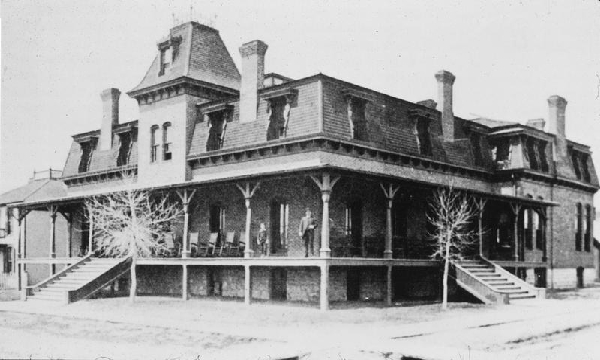
Cheyenne Club, approx. 1890
The Cheyenne Club, constructed in 1880, was located
at the northwest corner of 17th Street and present day Warren Avenue. The Club, in its fittings, was worthy of many a "Gentlemen's Club" any
place within the British Empire to which some of its members owed allegience. The fittings included
two grand staircases, tennis courts, wine vaults, and reading, dining, and smoking rooms. Alcohol was prohibited in the
reading room. On the third floor were private rooms. Although gambling was
forbidden, rumors circulated about high stakes games in the private rooms.
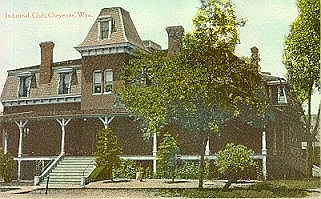 Industrial Club, undated
Industrial Club, undated
Utmost decorum was expected at all times. John Coble, now noted as having provided funds for
Tom Horn's defense, was suspended and then resigned after having discharged his .45 into
a painting hanging in the Club. Harry Oelrichs, who would arrive at the club in his $4,000, 16-passenger drag, was booted out of the
club after he kicked one of the club's stewards. [Writer's note: a drag is a private coach with seats on the top, in
addition to those inside. Its modern equivalent is a private, chauffeur-driven stretch limousine with
division] The club's membership, limited to 200, included some of the owners of the largest
ranches in the State. Rightly or wrongly, it has been alleged that the
plans for the Johnson County War were formulated within its precincts. Although it should be noted
that Asa Shinn Mercer in his Banditti of the Plains, or the Cattlemen's Invasion of Wyoming
in 1892 -- The Crowing Infamy of the Age suggests that the "invasion incubator" was former Governor Baxter's office
in the Commercial Block. Following the
Johnson County War, the Club defaulted on its bonds. The building then housed the
Industrial Club.
The clubhouse was torn down in 1936.
The Cheyenne Club served as a model for a similar club in Laramie. The Laramie Club, however,
was not so decorous. James W. Hayford, editor of the Laramie Sentinel, branded it "the lowest and
most disgraceful den of infamy in the city."
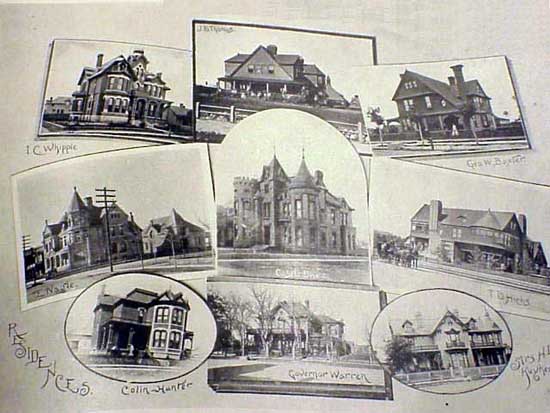
Homes on "Millionaire's Row, East 17th Street, approx. 1889. Photo by
C. D. Kirkland
The Nagle home at 222 E. 17th Street (left center) was constructed in 1888 and is now on the
National Register. Erasmus Nagle was the president and majority shareholder of the
Union Mercantile Company. Additionally, Nagle owned cattle interests in
present day Converse and Platte Counties, and with Henry G. Hay, Thomas Sturgis,
F. E. Warren, William W. Corlett, and Philip Deter, was an organizer of the
Cheyenne & Northern Railroad. Shortly, after the above photo was produced, Nagle died.
His widow remarried. Her new husband took her stock in the Union Mercantile and
mortgaged the house. The house was sold to F. E. Warren about 1910.
The Truman B. Hicks house, center right constructed about 1886, was designed by New York architects, William A. Bates and
George D. Rainsford, and is typical of many of Bates' asymetrical shingle-style designs. Rainsford (1850-1935),
said to be "the most profane man on the range,"
established a horse-breeding ranch west of Chugwatger, raising Morgans and Clydesdales. Surplus horses
were then shipped east to stables owned by Rainsford outside of New York. Rainsford provided some of the
initial horses for a federally owned horse-breeding operation in Colorado. the Rainsford Historical District in
Cheyenne is named because of the prevelence of Rainsford designed houses located there. Rainsford later
moved back to New York and died on December 26, 1935 at the Princess Issena Hotel in Daytona
Beach, Florida. The hotel later burned down and its site is occupied by a bank.
Hicks (1844-1908) was president of the First National Bank and following the death of his first wife, married the widow of
Amasa R. Converse and was president of the Converse Cattle Company. He additionally served on the school board and as Grand Commander of the Grand
Commandery of Wyoming.

Francis E. Warren
The I. C. Whipple house at 300 E. 17th Street (upper left) was constructed in 1883. The home is also on
the National Register and was constructed in 1883. Ithamar C. Whipple was a
stock grower and banker. He also held an interest in the Union Mercantile, 1 share,
which was sold to the trustee for Erasmus Nagle's son, George, helping George to maintain a majority interest in the
company after his mother's new husband gained control over her shares.
Whipple arrived in Cheyenne in 1867. He was a founder of
the 1st Baptist Church, the Wyoming Stock Growers Association, and the Stock Growers
National Bank. The house was sold to John W. Lacey in 1894. The house is now occupied by the
American Hellenic Educational Progressive Association Lodge No. 211.
The Warren house (bottom center) was Francis E. Warren's residence while serving as governor.
As previously noted, Wyoming did not provide a governor's mansion until 1905. Warren (1844-1929) arrived in
Cheyenne in 1868 and engaged in stockgrowing and mercantile pursuits. He served as territorial
governor 1885-1886 and 1889-1890, as state governor in 1890 before resigned to become
United States senator. As senator he served 1890-1893 and 1895-1829. Hs biggest contributions were, however,
to the commerical development of Cheyenne. In addition to the Warren Livestock Company, still in business, a 1929 advertisement for the Warren
Companies noted:
Since the early eighties the Warren Companies have been active in promoting
needed enterprises in Cheyenne. The Brush-Swan Electric Light Co., and Cheyenne City
Gas Co., succeeded by the Cheyenne Light, Fuel & Power Co., early developed the
lighting business and district steam heating system. The F. E. Warren Mercantile
Co., Cheyenne Hotels Co., and Central Improvement Co. erected the Commercial
building, the Wyoming Block, the Hobbs, Huckfeldt & Finkbiner furniture store building, the Union
block, the Plains Hotel, and the Lincoln Theatre. When a theatre was badly needed, the Caitol Ave. Theatre Co., largely
a Warren Company, filled the need. The Warren Companies own approximately 50 family dwellings.
These and the sleeping rooms in the Wyoming and Commerical hotels supply needed convenience to
railroad men and others whose residence in Cheyenne is more or less transient.
For more on F. E. Warren, see Ft. D. A. Russell.
Castle Dare (center) was owned by David D. Dare. Dare was originally a photographer and painter with his studio
on Ferguson (now Carey). He became associated with John W. Collins with the
Cheyenne National Bank. The house was originally being constructed by Alexander H. Swan for his daughter. However, when
Swan lost his fortune, the property was sold to Dare for $30,000. Dare completed the house. About 1888, Collins and Dare appeared in
San Diego, California, where they established the California National Bank and the California Savings Bank. Each of the
banks shared banking rooms in the Methodist Block. There are some indications that money was raised for the
two banks by selling shares in a manner similar to a Ponzi scheme. Dare agreed that at the
option of the buyer he would repurchase shares at 110% of the sales price, so that
a buyer could not lose. Additionally, using money from the bank, Dare and
Collins established the San Diego Cable Railway Co. and a hotel. In San Diego, Dare constructed a $40,000 16-room Richardsonesque
brownstone turreted pile even more magnificent than Castle Dare in Cheyenne. The house, reputedly at the time the most costly
house in southern California, was designed by noted California architect William Sterling
Hebbard. In 1891, shortly before bank
examiners were to appear upon the scene, Dare departed for Europe. It was later discovered
that he bore with him some $200,000 of the banks' money. On November 12, 1891, both of the San Diego banks closed their doors with
shortages of $800,000. In domino fashion there were other failures. The street railway failed. The day after the
San Diego bank failures, the Cheyenne National Bank closed its doors.
On March 3, 1892, Collins committed suicide in his rooms at the Brewster Hotel in
San Diego. D. D. Dare died in Athens, Greece, in December 1909, never having returned
to the United States. In Cheyenne, Castle Dare later became a funeral home and was razed in
1963 in order to construct a parking lot. The carriage house, however, is still in
existence.
Of the other houses, Colin Hunter (lower left) was a stockgrower, owner of the YT in northern Wyoming and
Montana, and Truman B. Hicks (middle right) was a banker. George W. Baxter (upper right) served as territorial governor for approximately one month before
he resigned. He was additionally a stockgrower.
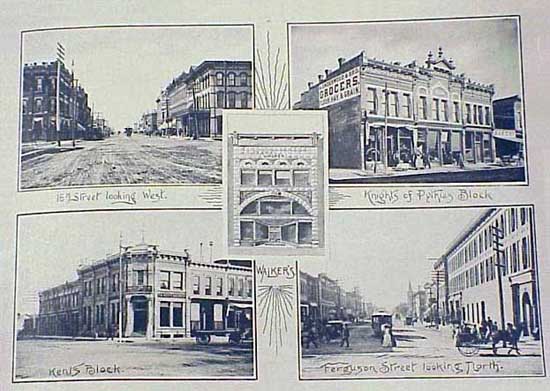
Commercial Buildings, Cheyenne, approx. 1889. Photo by
C. D. Kirkland.
Kent's Block, on the southeast corner of 17th and Ferguson (now Carey) was a bank owned by Thomas A. Kent, a stockman and banker.
The building was constructed in 1882. The bank served as a
depository for both the State and Laramie County. On July 20, 1893, the bank without warning,
probably as a result of the Panic of 1893, failed. Found in the bank's
vault was $2,058.17. On deposit with other banks was $1,684.32. Laramie
County had on deposit with the bank $12,642.33 and the State $44,642.33.
The Knights of Pythias Lodge No. 122 was instituted in 1870, only six years after the
Order's founding in Washington, D. C. in 1864. The Lodge Building at 312 W. 17th St. was constructed
in 1884 and is still occupied by the Lodge. It was used for the 1886 sitting of the Legislature.
As indicated by the next photo, however, it has been somewhat
modified. The ornate pediment and the front facade of the main portion of the building have been removed and covered up with a
new front facade made of blue panels making the building hardly recognizable. Even on the west 1/3 of the building, the
windows have been replaced with new smaller windows disporportionate to the style of the building. As indicated
in the photo, on the day the photo was taken the building featured a flea market and haunted house.
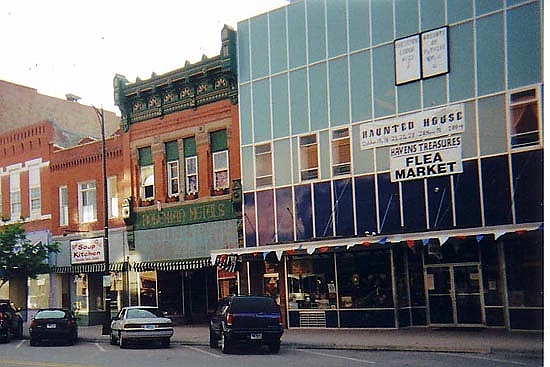
Knights of Pythias Building, 2005. Photo by Geoff Dobson
At one time the Knights of Pythias had almost a million
members in approximately 2,000 lodges in the United States and Canada. Today, the
Order has approximately 40,000 members in some 624 lodges.
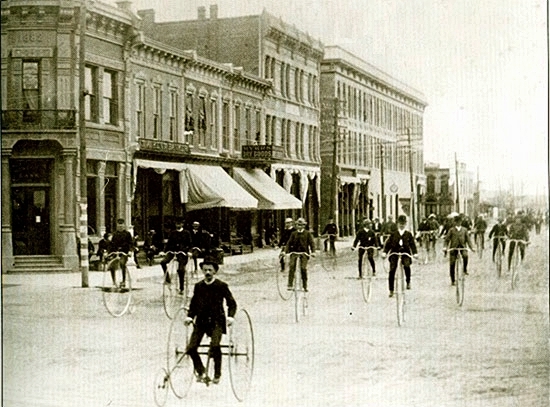
Wheelmen heading north on Ferguson at intersection with 17th Street. Kent's
Bank on corner. Photo by
C. D. Kirkland, 1885.
Most of the Wheelmen in the photo are riding "ordinary" bicycles ("penny farthings"). The three-wheeled
tricycle in the front appears to be a Columbia Tricycle built by the Pope Manufacturing Company. The modern
"safety bicycle" was not introduced until 1885. In
1884, Thomas Stevens began his epic journey around the world on a $90.00 Columbia ordinary. In his 1887
account of his adventures,
Around the World on a Bicycle, Stevens described his June 1884 arrival in Cheyenne:
My road is now over Cheyenne Pass, and from this point is mostly down-grade to Cheyenne. Soon I come to a
naturally smooth granite surface which extends for twelve miles,
where I have to keep the brake set most of the distance, and the constant
friction heats the brake-spoon and scorches the rubber tire black.
To-night I reach Cheyenne, where I find a bicycle club of twenty members,
and where the fame of my journey from San Francisco draws such a crowd on
the corner where I alight, that a blue-coated guardian of the city's
sidewalks requests me to saunter on over to the hotel. Do I. Yes, I
saunter over. The Cheyenne "cops" are bold, bad men to trifle with. They
have to be "bold, bad men to trifle with," or the wild, wicked cow-boys
would come in and "paint the city red " altogether too frequently.
Stevens' bicycle was destroyed in a scrap metal drive during World War II.
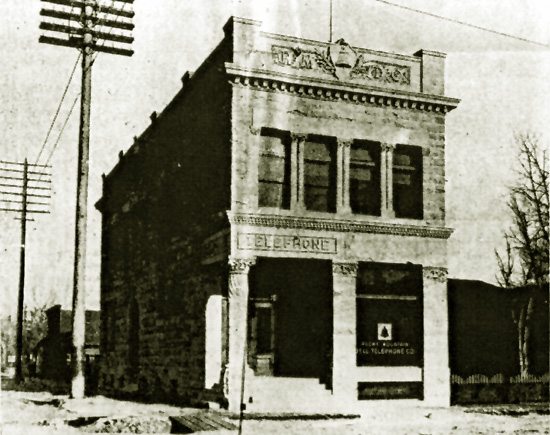
Mountain States Bell Telephone Building, S. E. Corner of Capitol Ave. and 17th, photo by J. E. Stimson, 1906.
As an indication of how advanced Cheyenne was,
Cheyenne's telephone exchange was organized in 1881, only three years after
Professor Bell demonstrated his new invention to Queen Victoria by connecting the Queen's
summer residence Osborne House with London. By the time of the above photo, long distance lines had been
extended westward to Ogden, Untah and northward into the Big Horn Basin and into Montana. As indicated in the
next two photos, a third-story was later constructed on the top of the building.
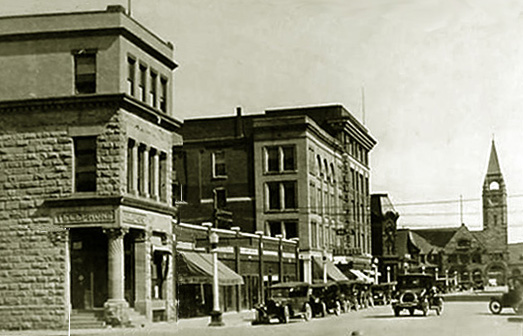
Mountain States Bell Telephone Building, S. E. Corner of Capitol Ave. and 17th, 1920's.
The building was later converted into a hotel. The building is still in existence although the first
floor facade has been modernized a bit.
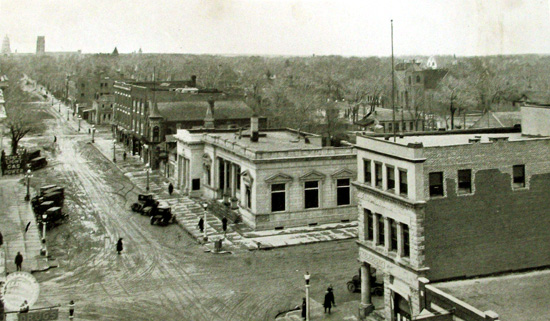
Stockgrowers National Bank, N. E. Corner of Capitol Ave. and 17th, 1920's Photo by J. E. Stimson.
The Bank was organized in 1881 by J. M. Carey, Thomas Sturgis, and Henry G. Hay, Sr. It was the only
bank in Cheyenne to survive the Panic of 1893. The corner is now occupied by the Wells-Fargo Bank.
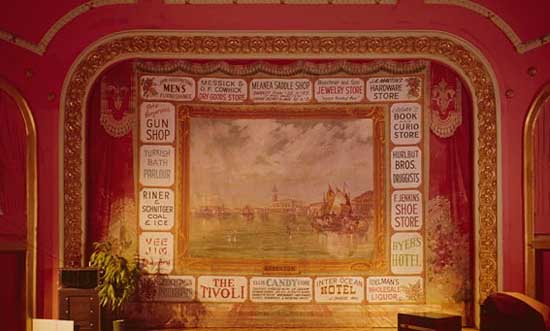
Atlas Theatre painted backdrop and proscenium, 1974. Photo by
Jack Boucher courtesy of Library of Congress, Prints and Photographs Division
The backdrop, itself, is not particularly
historic, but is illustrative of businesses that were operating in Cheyenne about 1900.
The Atlas Theatre Building at 213 W. 16th Street was constructed in 1887. The first floor
was retail space occupied by a confectionary and tea shop. The upper floors were occupied by
professional offices. In 1908, the building was reconfigured to a theatre first known as the
Atlas and later in 1929 as the Strand. Today the building is occupied by a little
theatre and is on the National Register.
Among the business listed is Frank A. Meanea's Saddle Shop which was located at 218
W. 17th Street. Leather items such as chaps, saddles, holsters made by Meanea are highly
collectable and valuable. Meanea (1849-1928) arrived in Cheyenne in 1867. For a period of time
Meanea worked for E. L. Gallatin who opened the shop in 1873. Meanea purchased the shop from
Gallatin in 1880 and continued to operate it until his death in 1928. His motto was,
"If it can be made in leather, we do it." Deputy United States Marshal, Joe LeFors, in his
autobiography, indicated that he was first introduced to the infamous shootist Tom Horn by Cheyenne
Chief of Police Sandy McNeil in Meanea's Saddle Shop. Frank Meanea's brother, Theodore,
operated a shop in Denver.
Cheyenne Photos continued on next page.
|